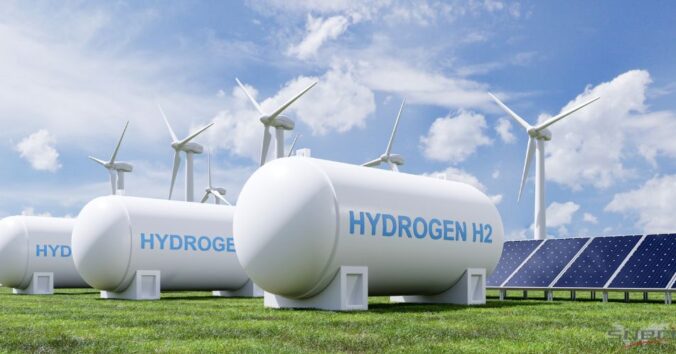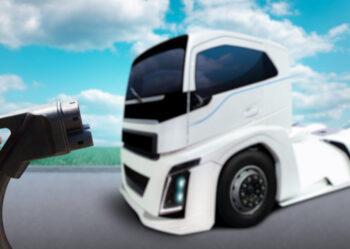Is the hydrogen vehicle really interesting?

With new regulations in place for 2035 banning the production of internal combustion vehicles, electric vehicles are booming and hydrogen vehicle technology is also developing.
Hydrogen is seen as a decarbonized energy source for a more environmentally friendly user experience, yet hydrogen production is not all that green.
Let’s take a closer look at whether the hydrogen vehicle of the future is really worthwhile.
What is hydrogen?
Before going into the details of the plan, let’s briefly recall what hydrogen is.
Hydrogen is very abundant on the surface of our planet. However, it does not exist in a pure state.
Composed of two hydrogen atoms (H₂), it is the most abundant chemical element on earth.
This invisible gas is also the lightest and is only rarely present in its natural state. It is therefore considered an energy carrier and not a direct energy source because its use requires a precise chemical process beforehand (production, storage, isolation of the element, etc.).
When we talk about hydrogen vehicles, we are actually talking about fuel cell electric cars.
This type of vehicle is powered by one or more electric motors and the main difference lies in the method of energy storage.
While conventional electric vehicles rely on battery technology, hydrogen vehicles are fuel cell vehicles.
However, there is another alternative, that of the internal combustion engine car, using dihydrogen as a fuel to replace diesel or petrol.
It should be noted that the dihydrogen molecule consists of two hydrogen atoms (H2). Its combustion with oxygen (O2) produces only water (H2O): 2H2 + O2 -> 2H2O.
Colorless, odorless and non-corrosive, dihydrogen has the advantage of being particularly energetic. The combustion of 1 kg of this gas releases about 3 times more energy than 1 kg of petrol (i.e. 120 MJ/kg compared to 45 MJ/kg for petrol).
On the other hand, as this gas is not very dense, it occupies a much larger volume than other gases of the same mass. Thus, to produce as much energy as with 1 liter of petrol, 4.6 liters of dihydrogen compressed to 700 bars are required. These large volumes are a constraint for transport and storage in gaseous form.
Like many fuels, hydrogen can ignite or explode in contact with air.
It must therefore be used with care. However, the small size of its molecules means that it diffuses very quickly in the air (four times faster than natural gas), which is a positive factor for safety.
Hydrogen vehicles have many advantages :
- They emit less CO2 and are therefore less polluting : as the hydrogen vehicle operates like an electric car, polluting emissions during operation are almost zero (with the exception of braking particles and tires); only water vapor results from the chemical reaction. Indeed, without combustion of the engine, the vehicle does not release any Co2, the car does not release fine particles or CO2.
Moreover, another significant advantage for certain cities that have introduced EPZs is that hydrogen vehicles benefit from the precious green Crit’Air sticker, which allows them to travel freely, even during pollution peaks.
- Greater autonomy than electric vehicles : the other advantage of hydrogen vehicles is that, unlike electric vehicles, their autonomy is reduced and the time spent recharging can be considerable. For example, the Toyota Mirai has a range of 1,300 km on a single tank, an absolute record, while the Hopium Machina has a range of 1,000 km on a single tank.
Moreover, filling a hydrogen tank would take no more than 5 minutes and is done at the pump. This brings this technology closer to our habits with combustion cars.
- Equivalent performance: Equipped with one or more electric motors, hydrogen vehicles offer great driving quality. For example, the Hopium Machina boasts a powertrain of 500 horsepower to accelerate from 0 to 100 km/h in just 5 seconds.
With no noise, no vibration and no smell, driving a fuel cell-electric vehicle allows you to really concentrate on what’s important – driving.
- Subsidies for purchase: As with electric cars, FCEVs (Fuel Cell Electric Vehicles) are eligible for the green Crit’Air sticker, which makes it easier to drive in the EPZs as mentioned above, but above all hydrogen vehicles are also eligible for State aid at the time of purchase, such as the ecological bonus, the conversion premium and various local aids.
However, hydrogen has some disadvantages :
- Only few brands are developing and offering this technology. In France, only two new models are available: the Toyota Mirai, the sister car of the Prius, and the Hyundai Nexo SUV. In addition to the few models available, the prices are at least 70K€ for the Toyota and about 80K€ for the Hyundai SUV.
But other models are to come, such as the NamX HUV, the Hopium Machina or the future BMW iX5 Hydrogen.
- Few recharging stations: there are few hydrogen recharging stations in France, with around thirty in the country, clearly representing an insufficient offer to provide drivers with a serene experience. The government’s recovery plan provides for 7.2 billion euros of investment between now and 2030 to boost this technology.
- Not so economical: The price of a full tank of fuel varies from one model to another. For example, the Hyundai Nexo has a 6.33 kg hydrogen tank and a kilo of hydrogen costs between €10 and €15, which means a full tank costs around €70.
If we consider that this type of vehicle consumes an average of 1 kg/100 km, bringing the cost to about 11 €/100 km, this is still well above the price of a full tank of petrol.
In comparison, a diesel SUV consuming 5.5 l/100 km costs on average €10.16 to cover the same distance (average price of B7 diesel: €1.848).
- Too little efficiency: One of the main difficulties in the democratization of the hydrogen vehicle is related to its production and transport. There are several solutions for obtaining hydrogen.
The first two consist of obtaining dihydrogen either by gasification of fossil fuels (coal) or by reforming natural gas (methane), but the main drawback is the heavy emission of greenhouse gases. The hydrogen produced by these processes is called “grey hydrogen”.
The third solution, the one commonly envisaged, involves the electrolysis of water.
– Alkaline electrolysis : this is the most widespread technique for producing electrolytic hydrogen. It is a method of producing hydrogen by separating oxygen and hydrogen from water by an electric current in an alkaline (liquid) solution. It mainly uses a potassium hydroxide (KOH) solution. Alkaline electrolysis can, however, have problems when coupled with intermittent energy.
– PEM (Proton Exchange Membrane) electrolysis : This method uses a polymer membrane (PEM) as a solid electrolyte. The operating principle of a PEM electrolyser is based on the same concept as a fuel cell. The solid electrolyte thus ensures the conduction of atoms and allows the separation of gases to obtain hydrogen. PEM electrolysis allows decentralized production, thanks to a better reactivity to power variations.
– High temperature electrolysis : this process is based on the decomposition of water molecules at high temperature. Part of the energy required for the reaction is provided by the heat generated by this water vapor, which means that expensive catalysts (platinum, iridium, etc.) are not required. Thus, this method has an advantage in terms of costs, as it reduces those linked to the investment and operation of these types of catalysts.
However, it should be noted that all three methods require specific technologies and generate high costs.
The purchase, installation and use of electrolysers entail considerable expenditure.
In conclusion, the purchase and use of hydrogen vehicles remains low in the face of competition from more affordable and widespread electric or hybrid vehicles. While the advantages are undeniable, the issue of hydrogen production still needs to be resolved. If a choice has already been made between grey hydrogen, which is polluting but affordable, or green (or yellow) hydrogen, which has a lower yield and is much more expensive to produce, electricity production will also have to be able to meet needs.
SNECI & supporting tomorrow’s mobility professionals.
Automotive support plan for a green industry
To help companies in the sector adapt to this particularly difficult context, to guide them in the mobilization of the support mechanisms made available to them by the Automobile Plan, according to their own needs, the PFA and the DGE, supported by the government, have set up an automobile support plan through the expertise of certain partners such as SNECI
SNECI supports the players in the sector, enables them to respond to various changes such as structural changes (Environmental and regulatory, Digital and Societal) and economic changes (After years of growth in the automotive market, the last past years have been complicated for the sector and strong growth are expecting by 2030)
All of these factors have had a significant impact on the industrial tool and employment. A good number of industrialists have already anticipated these changes but a certain number of companies (ETI and SME) are still in difficulty and sometimes even in a situation of fragility or survival.
Part A – Definition of a diversification and restructuring strategy with a detailed plan.
- Analysis of the company’s strategy and strategic resources
- Identification of possible diversification/restructuring paths
- Definition and elaboration of a detailed action plan to ensure the necessary reconversions, both industrially, commercially and in terms of human resources: diversification of the customer and export portfolio, diversification of the product range within the automotive sector or within other sectors, or, failing that, restructuring or even reintegration of employees
Part B – Tailor-made support for the implementation of the action plan :
- To ensure support for the transformation project previously drawn up through the diversification plan (project monitoring/PMO, help in setting up support projects, finding partners, etc.)
Part C – Full operational support for industrialists
Supporting industrialists in improving their operational performance in terms of costs, quality and deadlines (diagnosis, action plan, implementation)
- Diagnosis and operational benchmarking of the beneficiary company’s industrial (including maintenance), service and/or administrative processes
- Identification of possible ways of optimizing these processes to improve the company’s operational performance and competitiveness, whether in terms of costs, quality or deadlines
- Definition and elaboration of a detailed action plan for process optimization
- Monitoring the implementation of the detailed action plan
- Orientation, depending on the company’s needs, towards complementary measures such as the support fund for the diversification of subcontractors in the automotive sector, specific consultancy modules offered by Bpifrance, regional aid measures, etc.
SNECI also offers optimization of industrial processes:
Our support in improving industrial performance is based on several axes:
- Industrial diagnosis & Industrial project management
- Definition of the action plan
- Assistance in implementing the action plan – audits
- Consolidation through training and coaching of teams
- Outsourcing of your support functions, purchasing and logistics
Our 450 experts in more than 50 countries are specialized in engineering and project management with a technical DNA and local approach to guarantee the results expected by our clients.
If you would like one of our industrial project managers to help you improve your processes for greater profitability (decarbonization, hydrogen, saving time, money and efficiency), send an email to Laura who will reply to you within 24hrs to arrange a meeting at laura@sneci.com or directly via the contact tab on our website.





